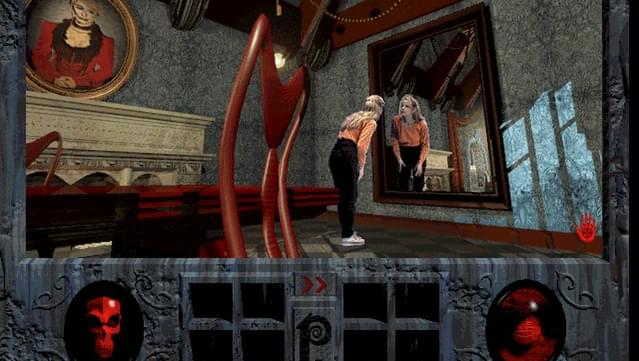
A picture of anything that would terrify the beholder should be placed in front of a camera obscura hole, with several torches around it.
Phantasmagoria game book how to#
In the 1589 version of Magia Naturalis, Giambattista della Porta described how to scare people with a projected image. By the 16th century, necromantic ceremonies and the conjuring of ghostly apparitions by charlatan "magicians" and "witches" seemed commonplace. Some ancient sightings of gods and spirits are thought to have been conjured up by means of (concave) mirrors, camera obscura or magic lantern projections. Giovanni Fontana's drawing from circa 1420 of a figure with lantern projecting a winged demon

De Philipsthal and Philidor are believed to have been the same person. De Philipsthal's show of optical illusions and mechanical pieces of art in London in 1801. The English variation Phantasmagoria was introduced as the title of M. Phylidor had previously advertised his show as Phantasmorasi in Vienna in March 1790.

The letter also promoted Phylidor's show. About two weeks earlier the term had been the title of a letter by a certain "A.L.M.", published in Magazin Encyclopédique. Paul Philidor (also known simply as "Phylidor") announced his show of ghost apparitions and evocation of the shadows of famous people as Phantasmagorie in the Parisian periodical Affiches, annonces et avis divers of December 16, 1792. įrom French phantasmagorie, from Ancient Greek φάντασμα ( phántasma, “ghost”) + possibly either αγορά ( agorá, “assembly, gathering”) + the suffix -ia, or ἀγορεύω ( agoreúō, “to speak publicly”). The word "phantasmagoria" has also been commonly used to indicate changing successions or combinations of fantastic, bizarre, or imagined imagery. The shows started under the guise of actual séances in Germany in the late 18th century and gained popularity through most of Europe (including Britain) throughout the 19th century. Such elements as required fasting, fatigue (late shows), and drugs have been mentioned as methods of making sure spectators would be more convinced of what they saw.

Some shows added a variety of sensory stimulation, including smells and electric shocks. In many shows, the use of spooky decoration, total darkness, (auto-)suggestive verbal presentation, and sound effects were also key elements.
Phantasmagoria game book portable#
Mobile or portable projectors were used, allowing the projected image to move and change size on the screen, and multiple projecting devices allowed for quick switching of different images. info), also fantasmagorie, fantasmagoria) was a form of horror theatre that (among other techniques) used one or more magic lanterns to project frightening images, such as skeletons, demons, and ghosts, onto walls, smoke, or semi-transparent screens, typically using rear projection to keep the lantern out of sight.Phantasmagoria ( American pronunciation ( help Interpretation of Robertson's Fantasmagorie from F.


 0 kommentar(er)
0 kommentar(er)
